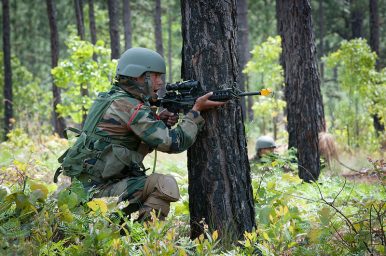Mikesingh
New Member
- Joined
- Sep 7, 2015
- Messages
- 7,353
- Likes
- 30,450
This is basically for the security of the CPEC running through POK and GB.Now chinkies and piggies are having official joint patrols in POK. @Bornubus[/USER@]hammer head
This is basically for the security of the CPEC running through POK and GB.Now chinkies and piggies are having official joint patrols in POK. @Bornubus[/USER@]hammer head
can't comment on Itanagar but in Tawang if they hold the heights then it will be tough to recover the territory. As they can hold incoming Indian strikes for days.PLA heliborne force is incapable of capturing and holding on to Tawang or Itanagar independently and indefinately.
Nope they can't! Not a chance in hell!can't comment on Itanagar but in Tawang if they hold the heights then it will be tough to recover the territory. As they can hold incoming Indian strikes for days.
When Indian army retreated haphazardly in 1962 leaving all their rations and supplies behind. Combat engineers were send to destroy our own supplies so that Chinese don't use it for themselves.can't comment on Itanagar but in Tawang if they hold the heights then it will be tough to recover the territory. As they can hold incoming Indian strikes for days.
Not this time. Can't say more about it hereIt's normal
So from today we need to prime our own bases so that enemy can't use it and no need to send engineers to destroy.When Indian army retreated haphazardly in 1962 leaving all their rations and supplies behind. Combat engineers were send to destroy our own supplies so that Chinese don't use it for themselves.
1962 taught many lessons to Army. Infact all the major wars and operations.So from today we need to prime our own bases so that enemy can't use it and no need to send engineers to destroy.
I think no,look at the map there is only one road from tibet connecting tawang. If we can take it by artillery there road connectivity is dusted and they need to rely only on the air drops.can't comment on Itanagar but in Tawang if they hold the heights then it will be tough to recover the territory. As they can hold incoming Indian strikes for days.
Reminds me of the 1965 when we went to Lahore (only tactical reference).can't comment on Itanagar but in Tawang if they hold the heights then it will be tough to recover the territory. As they can hold incoming Indian strikes for days.
It was a watershed moment.1962 taught many lessons to Army. Infact all the major wars and operations.
 ) but consent and consensus is permission is sanction is endorsement. It all happened under PRC.
) but consent and consensus is permission is sanction is endorsement. It all happened under PRC. what was intent of Pakistan. What happened after that ... that is what we are and where we are.
what was intent of Pakistan. What happened after that ... that is what we are and where we are.Who's is going to survive 'Pakistan' at the rate it is being projected?This is basically for the security of the CPEC running through POK and GB.

I am no expert but Why do you think they will only carry three days of supply? It is also possible that extra supplied is aerial dropped along with them.Even a 10 days of supply will keep Indian troops engaged for 20 days. Due to height advantage.Heliborne troops don't have the wherewithal to fight beyond a max of three days. They have little or no arty support, no resupply and would thus soon run out of ammo, food and water. These heliborne troops can carry just about three days of supplies.
I was talking about the Tawang district. Obviously they cannot reach the proper town but they can hold on heights on Indian territory near Indo Chinese border.Tawang is 50km from the chinese border with lots of blind curves.


Yes.So now ching chong chinese have given Doka lam a ching chong name, Donglang lol
This is probably the highet level of threat till now. Lets see we need to wait for a month. I personally think nothing will happen even skirmish.
 They know the entire 7th fleet will land up at their back door; nothing will happen, only crying and psyop trials.
They know the entire 7th fleet will land up at their back door; nothing will happen, only crying and psyop trials. 
| Thread starter | Similar threads | Forum | Replies | Date |
|---|---|---|---|---|
|
|
Skirmishs at LOC, LAC & International Border | Indian Army | 13524 | |
|
|
LOC, LAC & International Border skirmishs | Indian Army | 1990 | |
| H | OSINT compilation thread | Knowledge Repository | 54 | |
|
|
LOC, LAC & IB warfare | Indian Army | 2005 |
